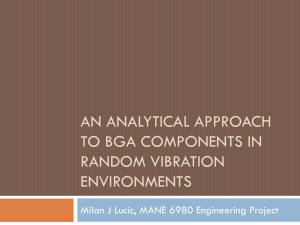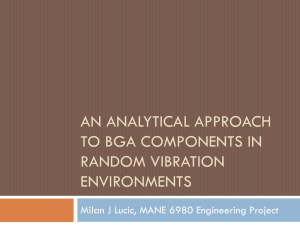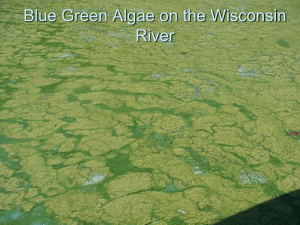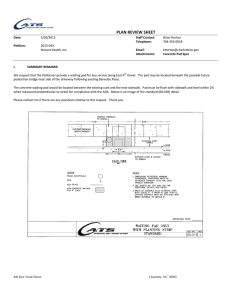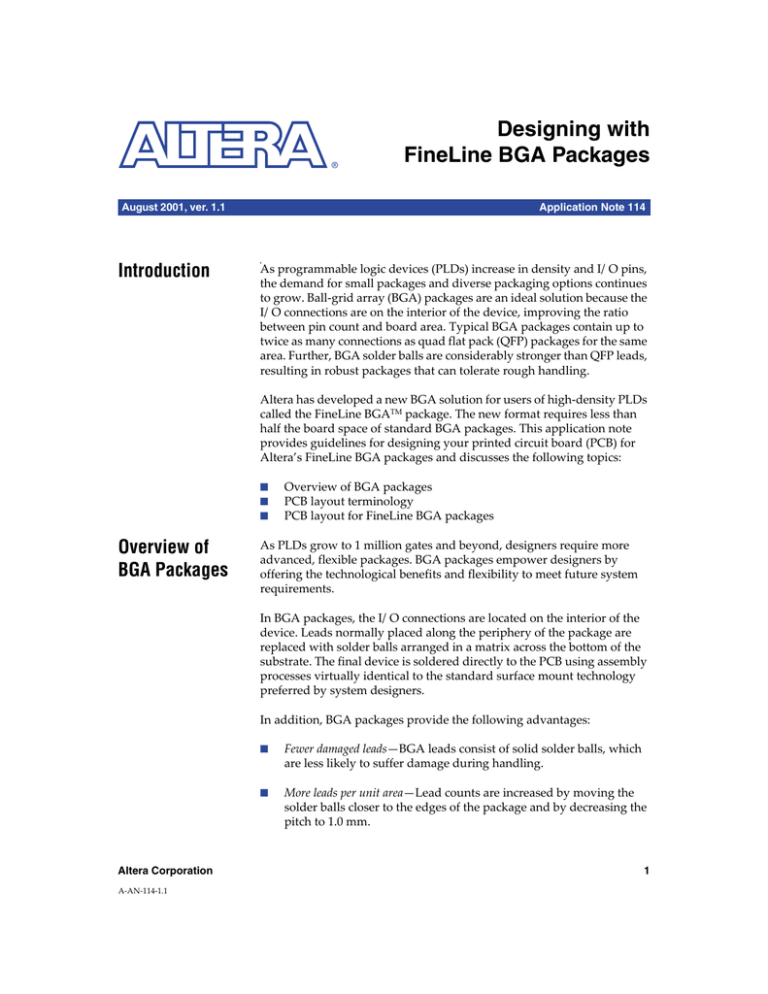
®
Designing with
FineLine BGA Packages
August 2001, ver. 1.1
Introduction
Application Note 114
6
As programmable logic devices (PLDs) increase in density and I/O pins,
the demand for small packages and diverse packaging options continues
to grow. Ball-grid array (BGA) packages are an ideal solution because the
I/O connections are on the interior of the device, improving the ratio
between pin count and board area. Typical BGA packages contain up to
twice as many connections as quad flat pack (QFP) packages for the same
area. Further, BGA solder balls are considerably stronger than QFP leads,
resulting in robust packages that can tolerate rough handling.
Altera has developed a new BGA solution for users of high-density PLDs
called the FineLine BGATM package. The new format requires less than
half the board space of standard BGA packages. This application note
provides guidelines for designing your printed circuit board (PCB) for
Altera’s FineLine BGA packages and discusses the following topics:
■
■
■
Overview of
BGA Packages
Overview of BGA packages
PCB layout terminology
PCB layout for FineLine BGA packages
As PLDs grow to 1 million gates and beyond, designers require more
advanced, flexible packages. BGA packages empower designers by
offering the technological benefits and flexibility to meet future system
requirements.
In BGA packages, the I/O connections are located on the interior of the
device. Leads normally placed along the periphery of the package are
replaced with solder balls arranged in a matrix across the bottom of the
substrate. The final device is soldered directly to the PCB using assembly
processes virtually identical to the standard surface mount technology
preferred by system designers.
In addition, BGA packages provide the following advantages:
Altera Corporation
A-AN-114-1.1
■
Fewer damaged leads—BGA leads consist of solid solder balls, which
are less likely to suffer damage during handling.
■
More leads per unit area—Lead counts are increased by moving the
solder balls closer to the edges of the package and by decreasing the
pitch to 1.0 mm.
1
AN 114: Designing with FineLine BGA Packages
PCB Layout
Terminology
■
Less expensive surface mount equipment—BGA packages can tolerate
slightly imperfect placement during mounting, requiring less
expensive surface mount equipment. The placement can be imperfect
because the BGA packages self-align during solder reflow.
■
Smaller footprints—BGA packages are usually 20% to 50% smaller
than QFP packages, making BGA packages more attractive for
applications that require high performance and a smaller footprint.
■
Integrated circuit speed advantages—BGA packages can operate well
into the microwave frequency spectrum and can achieve high
electrical performance by using ground planes, ground rings, and
power rings in the package construction.
■
Improved heat dissipation—Because the die is located at the center of
the FineLine BGA package and most VCC and GND pins are located at
the center of the package, the GND and VCC pins are located under the
die. As a result, the heat generated in the device can be transferred
out through the GND and VCC pins (i.e., the GND and VCC pins act as a
heat sink).
This section defines common terms used in PCB layout.
Escape Routing
Escape routing is the method used to route each signal from a package to
another element on the PCB.
Multi-Layer PCBs
The increased I/O count associated with BGA packages has made
multi-layer PCBs the industry-standard method for performing escape
routing. Signals can be routed to other elements on the PCB through
various numbers of PCB layers.
Vias
Vias, or plated through holes, are used in multi-layer PCBs to transfer
signals from one layer to another. Vias are actual holes drilled through a
multi-layer PCB and provide electrical connections between various PCB
layers. All vias provide layer-to-layer connections only; device leads or
other reinforcing material are not inserted into vias.
2
Altera Corporation
AN 114: Designing with FineLine BGA Packages
Table 1 describes the terms used to define via dimensions.
Table 1. Via Dimension Terms
Term
Definition
Aspect ratio
The aspect ratio is the ratio of a via’s length or depth to its
pre-plated diameter.
Drilled hole diameter
The drilled hole diameter is the diameter of the actual via
hole drilled in the board.
Finished via diameter
The finished via diameter is the diameter of a via hole that
has been finished.
Table 2 shows the three via types typically used on PCBs.
Table 2. Via Types
Type
Description
Through via
An interconnection between the top and the bottom layer
of a PCB. Through vias can also provide interconnections
to inner PCB layers.
Blind via
An interconnection from the top or bottom layer to an inner
PCB layer.
Embedded via
An interconnection between any number of inner PCB
layers.
Figure 1 shows all three via types.
Figure 1. Types of Vias
Through Via
Blind Via
Embedded Via
Connection
to Layer
PCB Layers
Altera Corporation
3
AN 114: Designing with FineLine BGA Packages
Blind vias and through vias are used more frequently than embedded
vias. Blind vias can be more expensive than through vias, but overall costs
can be reduced because signal traces can be routed under a blind via,
requiring fewer PCB layers. Through vias, on the other hand, do not
permit signals to be routed through lower layers, which can increase the
required number of PCB layers and overall costs.
Via Capture Pad
Vias are connected electrically to PCB layers through via capture pads,
which surround each via.
Surface Land Pad
Surface land pads are the areas on the PCB to which the BGA solder balls
adhere. The size of these pads affects the space available for vias and
escape routing. In general, surface land pads are available in the following
two basic designs:
■
■
Non solder mask defined (NSMD), also known as copper defined
Solder mask defined (SMD)
The main differences between the two surface land pad types are the size
of the trace and space, the type of vias you can use, and the shape of the
solder balls after solder reflow.
Non Solder Mask Defined Pad
In the non solder mask defined (NSMD) pad, the solder mask opening is
larger than the copper pad. Thus, the surface land pad’s copper surface is
completely exposed, providing greater area to which the BGA solder ball
can adhere (see Figure 2). Altera recommends that you use a NSMD pad
for most applications because it provides more flexibility, fewer stress
points, and more line-routing space between pads.
Solder Mask Defined Pad
In the solder mask defined (SMD) pad, the solder mask overlaps the
surface land pad’s copper surface (see Figure 2). This overlapping
provides greater adhesion strength between the copper pad and the PCB’s
epoxy/glass laminate, which can be important under extreme bending
and during accelerated thermal cycling tests. However, the solder mask
overlap shrinks the amount of copper surface available for the BGA solder
ball.
4
Altera Corporation
AN 114: Designing with FineLine BGA Packages
Figure 2. Side View of NSMD & SMD Land Pads
NSMD Pad
Solder
Mask
Solder Mask
Opening
SMD Pad
Solder
Mask
Copper
Pad
Solder Mask
Opening
Copper
Pad
PCB
Figure 3 shows the side view for an NSMD and SMD solder joint.
Figure 3. Side View of NSMD & SMD Solder Joints
NSMD Solder Joint
SMD Solder Joint
BGA Package
BGA Solder Ball
Solder Mask
PCB
Copper Pad
Stringer
Stringers are rectangular or square interconnect segments that electrically
connect via capture pads and surface land pads. Figure 4 shows the
connection between vias, via capture pads, surface land pads, and
stringers.
Figure 4. Via, Land Pad, Stringer & Via Capture Pad
Stringer
Via
Via Capture Pad
Surface Land Pad
Altera Corporation
5
AN 114: Designing with FineLine BGA Packages
PCB Layout for
FineLine BGA
Packages
When designing a PCB for FineLine BGA packages, consider the
following factors:
■
■
■
■
1
Surface land pad dimension
Via capture pad layout and dimension
Signal line space and trace width
Number of PCB layers
For all FineLine BGA figures, the controlling dimension is
millimeters.
Surface Land Pad Dimension
Surface land pads should be the same size as the BGA pad to provide a
balanced stress on solder joints. For this reason, Altera recommends using
a 15.75-mil surface land pad, because it is the same size as the BGA pad.
Figure 5 shows a 15.75-mil BGA pad.
Figure 5. 15.75-Mil BGA Pad
BGA Package
BGA Pad
BGA Solder Ball
0.40 mm
(15.75 mil)
0.63 mm
(25.00 mil)
Figure 6 shows how much space is available for vias and escape routing
when you use 15.75-mil surface land pads.
6
Altera Corporation
AN 114: Designing with FineLine BGA Packages
Figure 6. Space Available for 15.75-Mil Surface Land Pads
1.00 mm
(39.37 mil)
0.60 mm
(23.62 mil)
0.60 mm
(23.62 mil)
1.00 mm
(39.37 mil)
1.01 mm
(39.76 mil)
0.40 mm
(15.75 mil)
Surface Land Pads
Via Capture Pad Layout & Dimension
The size and layout of via capture pads affect the amount of space
available for escape routing. In general, you can layout via capture pads
in the following two ways: in-line with the surface land pads or in the
diagonal of surface land pads. Figure 7 shows both layouts.
Figure 7. Placement of Via Capture Pad
In Line
Diagonally
1.00 mm
(39.37 mil)
1.00 mm
(39.37 mil)
Surface land pad
Via capture pad
Vias
a
c
b
Stringer
a
b
c
Stringer length
a
b
Stringer width
Minimum clearance between via
capture pad and surface land pad
f
0.60 mm
(23.62 mil)
e
d
1.00 mm g
(39.37 mil)
c
d
0.40 mm
(15.75 mil)
d
e
Via capture pad diameter
f
g
Space width
e
Area for escape routing
(This area is on a different
PCB layer than the surface
land pads.)
f
Trace width
Altera Corporation
0.40 mm
(15.75 mil)
f
f
g
7
AN 114: Designing with FineLine BGA Packages
The decision to place the via capture pads diagonally or in-line with the
surface lands pads is based on the following factors:
■
■
■
Diameter of the via capture pad
Stringer length
Clearance between via capture pad and surface land pad
To decide how to lay out your PCB, use the information shown in Figure 7
and Table 3. If your PCB design guidelines do not conform to either
equation in Table 3, contact Altera Applications for further assistance.
Table 3. Formula for Via Layouts
Layout
Formula
In-line
a + c + d ≤ 23.62 mil
Diagonally
a + c + d ≤ 39.76 mil
Table 3 shows that you can place a larger via capture pad diagonally than
in-line with the surface land pads.
Via capture pad size also affects how many traces can be routed on a PCB.
Figure 8 shows sample layouts of typical and premium via capture pads.
The typical layout shows a via capture pad size of 27 mil, a via size of
8 mil, and an inner space/trace of 4 mil. With this layout, only one trace
can be routed between the vias. If more traces are required, you must
reduce the via capture pad size or the space/trace size.
The premium layout shows a via capture pad size of 20 mil, a via size of
5 mil, and an inner space/trace of 3 mil. This layout provides enough
space to route two traces between the vias.
Figure 8. Typical & Premium Via Capture Pad Sizes
Typical
Premium
39.37 mil
39.37 mil
Via
Via Capture Pad
Space
Trace
8.00 mil
27.00 mil
8
4 mil
5.00 mil
20.00 mil
3 mil
15.00 mil
Altera Corporation
AN 114: Designing with FineLine BGA Packages
Table 4 shows the typical and premium layout specifications used by
most PCB vendors.
Table 4. Vendor Specifications
Specification
f
Typical
(Mil)
Premium
(Mil)
Trace/space width
5/5
3/3
Drilled hole diameter
12
10
Finished via diameter
8
≤5
Via capture pad
25.5
20
Aspect ratio
7:1
10:1
For detailed information on drill sizes, via sizes, space/trace sizes, or via
capture pad sizes, contact your PCB vendor directly.
Signal Line Space & Trace Width
The ability to perform escape routing is defined by the width of the trace
and the minimum space required between traces. The minimum area for
signal routing is the smallest area that the signal must be routed through
(i.e., the distance between two vias, or g in Figure 7). This area is
calculated by the following formula:
g = 39.37 – d
The number of traces that can be routed through this area is based on the
permitted line trace and space widths. You can use Table 5 to determine
the total number of traces that can be routed through g.
Table 5. Number of Traces
Number of
Traces
Formula
1
g ≥ [2 × (space width)] + trace width
2
g ≥ [3 × (space width)] + [2 × (trace width)]
3
g ≥ [5 × (space width)] + [3 × (trace width)]
Figure 9 shows that by reducing the trace and space size, you can route
more traces through g. Increasing the number of traces reduces the
required number of PCB layers and decreases the overall cost.
Altera Corporation
9
AN 114: Designing with FineLine BGA Packages
Figure 9. Escape Routing for Double & Single Traces
Double Trace Routing
Single Trace Routing
Via Capture Pad
0.12 mm
(4.72 mil)
0.40 mm
(15.75 mil)
0.40 mm
(15.75 mil)
0.20 mm
(7.87 mil)
Space
Trace
0.60 mm
(23.62 mil)
0.60 mm
(23.62 mil)
0.40 mm
(15.75 mil)
0.40 mm
(15.75 mil)
Number of PCB Layers
In general, the number of PCB layers required to route signals is inversely
proportional to the number of traces between vias (i.e., the greater the
number of traces, the fewer the number of PCB layers required). You can
estimate the number of layers your PCB requires by first determining:
■
■
■
Trace and space size
Number of traces routed between the via capture pads
Type of vias used
Table 6 shows the number of PCB layers required to route signals for
various FineLine BGA packages in EPF10K50E devices, assuming the use
of a power plane, ground plane, and all I/O pins. This table shows that
using double traces and blind vias reduces the required number of layers.
Table 6. Minimum Required PCB Layers
FineLine BGA
Package (Balls)
10
Single Trace
Double Trace
Blind Vias
(Layers)
Through Vias
(Layers)
Blind Vias
(Layers)
Through Vias
(Layers)
100
2
2
1
1
256
2
2
2
2
484
2
3
2
2
672
3
4
2
3
Altera Corporation
AN 114: Designing with FineLine BGA Packages
Using fewer I/O pins than the maximum can reduce the required number
of layers. Via type can also reduce the number of layers required. To see
how the via type can affect the required number of PCB layers, consider
the sample layouts shown in Figure 10.
Figure 10. Sample PCB Layout
Blind Via
15.75-mil Surface
Land Pad
The signal from Ball 5
is routed under the via
and out the second layer.
Ball 5
Ball 4
Ball 3
Ball 2
Ball 1
22-mil Via
Capture Pad
8-mil Via
5-mil Trace
Through Via
The signal from Ball 5
is routed through the via
and out the third layer.
Ball 5
Ball 4
Ball 3
Ball 2
Ball 1
Signal travels out
through first layer
Signal travels out
through second layer
Signal travels out
through third layer
The blind via layout in Figure 10 requires only two PCB layers. The
signals from the first two balls can be routed directly through the first
layer. The signals from the third and fourth balls can be routed through a
via and out the second layer, and the signal from the fifth ball can be
routed under the vias for Ball 4 and Ball 3 and out the second layer.
Together, only two PCB layers are required.
In contrast, the through via layout in Figure 10 requires three PCB layers,
because signals cannot be routed under through vias. The signals from the
third and fourth balls can still be routed through a via and out the second
layer, but the signal from the fifth ball must be routed through a via and
out the third layer. Using blind vias rather than through vias in this
example saves one PCB layer.
Altera Corporation
11
AN 114: Designing with FineLine BGA Packages
Conclusion
Altera has taken a leadership position in PLD packaging with the recent
introduction of 1.00-mm FineLine BGA packages. These packages use a
reduced PCB area while maintaining a very high pin count. By using the
information in this application note, you can easily design PCBs to use
FineLine BGA packages, and take advantage of the package’s reduced
size.
Revision
History
Information contained in Application Note 114 (Designing with FineLine
BGA Packages) version 1.03 supersedes information published in previous
versions.
Version 1.1
Version 1.1 of Application Note 114 (Designing with FineLine BGA Packages)
contains the following changes:
■
Information in Table 6 was updated.
Version 1.03
Version 1.03 of Application Note 114 (Designing with FineLine BGA Packages)
contains the following changes:
■
■
Dimensions in Figures 5, 6, 7, 9, and 10 and Tables 3 and 6 were
updated.
Minor textual and style changes were made throughout the
document.
Version 1.02
Version 1.02 of Application Note 114 (Designing with FineLine BGA Packages)
contains the following changes:
■
■
The dimension of the BGA solder ball in Figure 5 was updated.
The surface land pad size in Figure 10 was updated.
Version 1.01
Version 1.01 of Application Note 114 (Designing with FineLine BGA Packages)
contains the following changes:
■
■
12
Information in Table 6 was updated.
Minor textual and style changes were made throughout the
document.
Altera Corporation
AN 114: Designing with FineLine BGA Packages
®
101 Innovation Drive
San Jose, CA 95134
(408) 544-7000
http://www.altera.com
Applications Hotline:
(800) 800-EPLD
Customer Marketing:
(408) 544-7104
Literature Services:
(888) 3-ALTERA
lit_req@altera.com
13
Altera and FineLine BGA are trademarks and/or service marks of Altera Corporation in the United States and
other countries. Altera acknowledges the trademarks of other organizations for their respective products or
services mentioned in this document. Altera products are protected under numerous U.S. and foreign patents
and pending applications, maskwork rights, and copyrights. Altera warrants performance of its
semiconductor products to current specifications in accordance with Altera’s standard warranty, but reserves
the right to make changes to any products and services at any time without notice. Altera assumes no
responsibility or liability arising out of the application or use of any information, product, or
service described herein except as expressly agreed to in writing by Altera Corporation.
Altera customers are advised to obtain the latest version of device specifications before
relying on any published information and before placing orders for products or services.
Copyright 2001 Altera Corporation. All rights reserved.
Altera Corporation
Printed on Recycled Paper.
AN 114: Designing with FineLine BGA Packages
14
Altera Corporation

